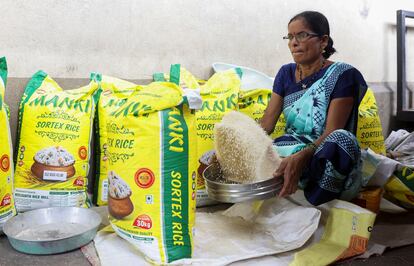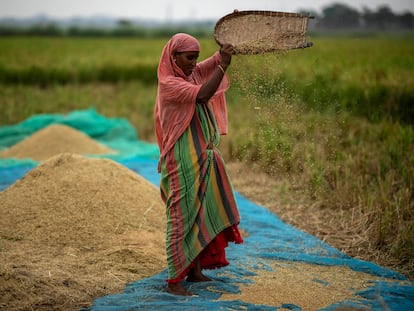India’s rice export ban fuels fears of inflation and global food shortages
The measure aims to control the rising prices of this essential dietary staple for the country’s low-income population

The global impact of the Covid-19 pandemic, the climate crisis and the Russian invasion of Ukraine has led to a significant increase in the number of people experiencing hunger. According to the latest United Nations Global Report on Food Crises, an additional 122 million people suffered from hunger last year compared to 2019. But now a new challenge has emerged — India has banned the export of non-basmati white rice. The country is the world’s largest rice exporter and the non-basmati variety accounts for 25% of its annual international sales. Added to an earlier ban on broken rice (fragments of rice) exports, this new restriction has raised concerns of global inflation and greater food insecurity for vulnerable populations.
Rice is a dietary staple for over three billion people (almost half the global population), and almost 90% is grown in Asia. The price of rice has remained more affordable than wheat or corn, even after the war in Ukraine began. However, the El Niño meteorological phenomenon has affected rice paddies, pushing up production costs and causing a 15%-20% increase in global prices since last September, according to the International Food Policy Research Institute (IFPRI). The monthly rice price index published by the Food and Agriculture Organization (FAO) indicates that it reached its highest level since 2008 in July.
To address this situation, India announced on July 20 that it was changing its export policy for non-basmati white rice. The goal is to ensure sufficient availability in the local market and prevent a surge in prices at the national level.
According to the FAO, the price of rice reached its highest level since 2008 in July
India’s rising consumer price index (CPI) is a politically sensitive issue for Prime Minister Narendra Modi, particularly with regional elections later this year and general elections in April 2024. Grains are a major part of the diet of the world’s most populous nation, particularly among lower-income groups. However, exporting grain is more profitable than selling it on the domestic market. According to government data, non-basmati white rice prices in India have risen by 11.5% this year, with a 3% increase from May to June — all because of higher foreign demand.
“We understand their [the government’s] motives. Indian authorities are trying to ensure food security while simultaneously addressing inflationary pressures,” said Luis Breuer, the International Monetary Fund’s representative for India. “That being said, any action taken by India will naturally have repercussions globally, including the potential for increased food price volatility... That’s why the IMF urges all nations, including India, to eliminate these types of export restrictions. They can have harmful global impacts.”
India is the world’s second-largest rice producer. China ranks first, but most of its rice is for domestic markets. India has been the leading rice exporter for nearly a decade. In 2022, it sold 22.3 million tons to over 140 countries, accounting for 40% of the global market share. These impressive figures were achieved despite implementing a restriction on broken rice shipments in September and imposing a 20% additional tariff on high-quality rice exports. Forty-two nations rely on India for over half of their rice imports. This demand cannot be easily met by other major exporters like Thailand, Vietnam and Pakistan. Some of the countries that are highly dependent on Indian rice include Bangladesh, Nepal, Benin, Senegal, Ivory Coast, Togo and Guinea.
“The new ban reinforces the one imposed last year,” said Shirley Mustafa, a commodity market analyst at the FAO. “Although it applies to a very specific type of rice [white Indica rice that is not basmati, aromatic or parboiled], it’s a very important element of Asian and African food supplies,” she said. Nearly half of India’s exports in 2022 consisted of non-basmati rice. Mustafa says that India has made exceptions and will offer broken rice to countries claiming food insecurity. The Indian Council for Research on International Economic Relations, one of India’s premier economic think tanks, says that for India to become a responsible leader in the G20 economic forum, the country must refrain from imposing sudden restrictions.
Countries that are highly dependent on Indian rice include Bangladesh, Nepal, Benin, Senegal, Ivory Coast, Togo and Guinea
Although India has enough reserves for its 1.4 billion people, the government is concerned about extreme heat and heavy monsoon rains that could damage the crop that will be harvested in September. In fact, despite the anticipated growth in cultivated land due to rising rice prices, Indian farmers have actually planted an area 6% smaller than in 2022.
On the news that India slapped an export ban on all non-basmati rice, the USA Rice Federation told American consumers, “Rest assured — there’s enough US rice to go around... This is not toilet paper in the Spring of 2020. This is rice, and US rice farmers in seven states grow rice sustainably on three million acres with more than enough supply to fill rice cookers and pots in every corner of the country.”
Agri-food export bans have become increasingly prevalent. Since the onset of the war in Ukraine, the number of countries implementing these bans has risen from three to 16, as reported by IFPRI. Indonesia has banned palm oil exports, Argentina restricted beef exports, and both Turkey and Kyrgyzstan have banned exports of certain grains. In the early days of the Covid-19 pandemic, at least 21 nations implemented similar restrictions.
Sara Mbago-Bhunu, Regional Director for Eastern and Southern Africa at the UN International Fund for Agricultural Development (IFAD), believes that opportunities can also emerge from a crisis. She points to long-running efforts by Tanzania, Kenya and Uganda to reduce their dependence on other countries and lessen the effects of protectionist measures. “They are expanding irrigated agricultural areas and implementing an innovative approach to intensify rice cultivation. This method boosts production while also facilitating the integration of rice farming with aquaculture.”
Mbago-Bhunu added: “Rice cultivation uses 40% of the world’s irrigation water and contributes significantly to climate change, as rice paddies account for 10% of global methane emissions.” She believes this is an opportunity for India to gain credibility “[... ] by using this period of sufficient rice reserves to improve intensive farming systems and adopt more sustainable practices for reducing greenhouse gas emissions.”
Sign up for our weekly newsletter to get more English-language news coverage from EL PAÍS USA Edition
Tu suscripción se está usando en otro dispositivo
¿Quieres añadir otro usuario a tu suscripción?
Si continúas leyendo en este dispositivo, no se podrá leer en el otro.
FlechaTu suscripción se está usando en otro dispositivo y solo puedes acceder a EL PAÍS desde un dispositivo a la vez.
Si quieres compartir tu cuenta, cambia tu suscripción a la modalidad Premium, así podrás añadir otro usuario. Cada uno accederá con su propia cuenta de email, lo que os permitirá personalizar vuestra experiencia en EL PAÍS.
¿Tienes una suscripción de empresa? Accede aquí para contratar más cuentas.
En el caso de no saber quién está usando tu cuenta, te recomendamos cambiar tu contraseña aquí.
Si decides continuar compartiendo tu cuenta, este mensaje se mostrará en tu dispositivo y en el de la otra persona que está usando tu cuenta de forma indefinida, afectando a tu experiencia de lectura. Puedes consultar aquí los términos y condiciones de la suscripción digital.
More information
Archived In
Últimas noticias
Most viewed
- Sinaloa Cartel war is taking its toll on Los Chapitos
- Oona Chaplin: ‘I told James Cameron that I was living in a treehouse and starting a permaculture project with a friend’
- Reinhard Genzel, Nobel laureate in physics: ‘One-minute videos will never give you the truth’
- Why the price of coffee has skyrocketed: from Brazilian plantations to specialty coffee houses
- Silver prices are going crazy: This is what’s fueling the rally











































